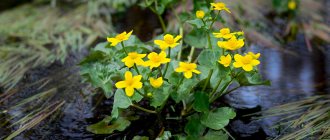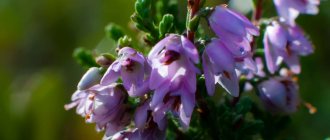Botanical description
The plant reaches 1-2 m in height. It has a long creeping stem. The leaves are pinnate, compound, pointed and with a mustache. The root of the plant is long and branched.
Source: Depositphotos
Forest chin is listed in the Red Book
The flowering of the forest rank pleases the eye with its pink or purple flowers. This process occurs in the summer. They can be 1.5-2 cm in diameter. The flowers are collected in racemes, the peduncle is always larger than the leaves, but there are rare exceptions.
The corollas are green on the outside, pink on the inside, and the wings are raspberry-colored. The tree bears fruit from July to September. The fruits are oblong and large - from 5 to 10 cm. Inside the bean there are from 2 to 6 seeds. They have a tetrahedral shape. Colored yellow-white, brown or gray. The seeds vary in size.
Where does the forest rank live:
- in areas of edges and clearings - where there are pine and small-leaved forests;
- among the bushes;
- on forest roads;
- less common on river slopes.
The plant loves a lot of light and warmth, so it can rarely be found in shaded areas.
Types and varieties of sweet peas
The genus Lathyrus is part of the Legume family (Fabaceae). About 100 species of peas are known, growing in the temperate and subtropical zones of the globe. The scientific name of the genus comes from the Greek words la - very and thuros - attractive.
Other types of china have not yet become as widespread as sweet peas. Less known are the annual relatives of the sweet pea, such as the Tangier pea (L. tingitanus) and the chloranthus pea (L. chloranthus). These species are very unpretentious. They are undemanding to soil and cold-resistant. They grow quickly. They are used for vertical gardening and the design of gazebos.
An interesting variety is the dwarf sweet pea, which forms dense bushes. Its low, raised shoots grow to approximately 15-30 cm in height. Dwarf peas are great for growing in flower beds as they do not require support. This low-growing variety also looks good on terraces and balconies.
Properties and Application
The perennial contains cyclitol and bornesitol. The flowers contain vitamin C, malvidin, and a large amount of phosphorus and calcium salts. Also found were carotene, alkaloids, protein, flavonoids kaempferol and quercetin, vitamin P, organic acids, and leukoanthocyanins. Chromium, copper, aluminum, manganese and iron are present in the rhizome and foliage.
Almost all parts of the plant are actively used in medicine. These are foliage, stems and flowers. Its seeds are poisonous, so they are not used.
A decoction and water infusion from the roots is used during:
- epileptic syndrome;
- colds;
- syphilis;
- pain in internal organs if any injury has occurred.
Sometimes chin is used as a wound healing and diuretic. Healers use herbs to treat various tumors, venereology diseases, leukocytosis, and infectious hepatitis. Infusions are excellent during fever, heart disease and insomnia.
To prepare the decoction, take 10–15 g of dry raw material and boil it in 200 ml of water for about 20 minutes. Then leave for 1.5 hours and filter. Drink 10 ml three times a day.
Before using the medicine, consult your doctor. And while taking it, monitor your body’s reaction to the drugs.
Perennial sweet pea
So far, perennial tree species that do not require special care and bloom profusely are also rare. However, their flowers are not large. The broadleaf chin (L. latifolius) is very easy to grow; its climbing stems reach 2 m in length. The flowers are large, pink-carmine or white. It blooms from June for approximately three months. Overwinters without shelter. Propagated by seeds (they do not set well) and by dividing the bush.
Growing perennial sweet peas from seeds
Seeds of perennial species can be sown both in spring and autumn.
Shoots appear in approximately two weeks. With timely picking of seedlings and proper care, well-developed bushes are formed by autumn, which can be planted in the ground in a permanent place. Seedlings bloom in the second year.
Of the perennial peas, one of the most decorative is the tuberous pea (L. tuberosus) with shoots up to 2 m high and small - up to 3-4 cm long and 1.5 cm thick - oblong tubers. Its flowers are fragrant, dark pink in color. Blooms from late June to mid-August. Easily propagated by seeds and division of rhizomes, it grows quickly, producing shoots around the mother plant. Since tuberous peas behave aggressively, displacing other plants, it is better to plant them separately from other flower crops. Stems reaching a height of 150-200 cm need support.
Cultivation of forest rank
The plant is listed in the Red Book, which is why it is under protection, so this rare endangered species is prohibited from being collected even for medicinal purposes. So we advise you to grow the plant in your own area.
Place
In general, the forest china is a shade-tolerant plant, but it grows and blooms better in well-lit places, protected from wind and drafts.
In this case, you need to change the planting location every year.
The soil
China does not put forward specific requirements for the composition of the soil. But for your own peace of mind, plant it on fertile soil with a neutral acidity level.
Caring for sweet peas
The plant requires regular watering. If there is a lack of moisture, few flowers appear, they are small and quickly fall off. Strong differences between day and night temperatures can also lead to the fall of buds and flowers. This flyer requires special attention during hot and dry weather. Since peas have a deep root system, water them abundantly and thoroughly at this time. To preserve moisture in the soil, it is better to mulch it with a small (3-5 cm) layer of humus or peat.
Recommended for you:
- sweet pea
- China fragrant
- Flowers with a pleasant smell
- Fragrant tobacco (hybrid)
Soil and fertilizer
This summer plant grows quickly and blooms profusely, removing large amounts of nutrients from the soil. It achieves its greatest decorative effect with abundant nutrition. It grows well on any clay and sandy fertile soils, but it is still better on deeply cultivated, well-fertilized, light or medium in physical composition and loamy neutral or slightly alkaline in acidity. Since peas have a taproot system that penetrates deep into the ground, the soil should be tilled to a depth of 30, or even better, 40 cm before planting.
Sweet peas do not like heavy clay soil - it retains moisture well, but quickly compacts and does not provide sufficient aeration. Air permeability can be improved by adding sand and a large amount of organic matter.
Sandy soils are not entirely suitable for this plant. They quickly absorb moisture, but do not retain it well. Fertilizers are also washed out of such soil more quickly. To improve their properties, you can add clay to them and thoroughly fertilize them with compost or humus. Adding compost or well-rotted manure will increase the fertility of sandy soils. Fresh manure cannot be used. This can lead to the death of plants from fungal diseases.
Pruning and feeding sweet peas
To get large inflorescences, it is better to leave several of the strongest stems on the plant and cut out the rest.
By regularly pruning some of the side shoots, flowering is stimulated. Another way to prolong abundant flowering is to remove faded inflorescences.
If you regularly cut off the inflorescences from the beginning of flowering, this will not harm the peas at all. Moreover, cutting is a good way to extend the flowering period. It stimulates the appearance of new flowers that are in no way inferior to cut ones. Seeds should not be allowed to form; they absorb a significant amount of nutrients. Abundant flowering is promoted by fertilizing - at least twice a season with liquid organic or mineral complex fertilizers. When the first buds appear, fertilizing with potassium-phosphorus fertilizers is useful.
You can decorate your balcony with sweet peas. It grows well in spacious balcony boxes; you just need to take care of the supporting support in advance. It can be frames with cords stretched vertically, coarse mesh, gratings of various shapes.
Reproduction
There are two methods of propagation: by sowing seeds and dividing the rhizome. But due to the fact that the plant’s root system is deep and very sensitive, the method is complicated and ineffective. Therefore, we will talk about the propagation of china using seeds.
The seeds of the plant are covered with a hard shell, so stratification must be carried out before sowing. To do this, first rub the seeds with sandpaper, then soak the seeds in very warm, but not hot, water overnight.
When they hatch, you can immediately sow them in a flowerbed in early April or in peat pots.
Source: Depositphotos
China will decorate the area and attract many bees to your garden
Sowing seeds in peat pots
The soil in the pot should consist of soil, peat and sand in a ratio of 2:1:0.5. Place 2-3 seeds in each pot. The first shoots will appear in 5-8 days.
The seedlings will need to be pinched when they have 2-3 true leaves. This will cause side shoots to form, making the plant more bushy.
Plant seedlings in the flowerbed in early May. The distance between plantings should be 25-30 cm.
General description of the plant
Sweet chin (Lathyrus odoratus)
The plant is distinguished by long and clinging stems. The tallest variety reaches 2 meters. The flowers have a disproportionate moth-like shape, the peduncles grow about 50 cm, with a raceme inflorescence at the very top. The opened buds begin to please the eye in July. The most popular colors: orange, red, pink, blue, blue, beige, lilac, violet.
Varieties of culture
A large number of varieties and varieties have been bred. Let's look at the most popular ones in the middle zone of the country:
- Fragrant (Lathyrus odoratus). The most famous species that is found in gardens and parks all over the world. The annual, up to 2 meters high, has large and rich flowers with a persistent aroma. Flowering begins in July and lasts until September. The most popular varieties from this group are “Promise” and “Matukana”.
Broadleaf chin (Lathyrus latifolius) - Broadleaf (Lathyrus latifolius). A perennial developed in the 16th century. Height – 2-3 meters, mounted on supports. The inflorescences are pink, bright red (sometimes white), formed in 3-8 pieces, and have no odor. Flowering begins in June. This variety is frost resistant.
- Gmelina (Lathyrus ochraceus). Prefers to grow in coniferous areas. These are perennials that grow up to 50-150 cm and have erect stems. The petals open yellow and turn orange at the end of flowering. The opening of beautiful buds starts in June.
- Forest (Lathyrus sylvestris). A perennial crop, widespread in Europe, the plant height is up to 2 meters, characterized by a creeping branched rhizome. It stands out for its large petals of rich crimson color. Excellent honey plant.
Chin of Gmelin (Lathyrus ochraceus)
Features of planting and care
If you don’t want to sow seeds every year, plant a perennial plant that will delight you for many years. If planted correctly, flowers can be seen in the first year.
Growing rank does not take much time. In the driest weather, it needs to be watered once every seven days, but very intensively, about 30 liters of water per 1 square meter. It needs 3 times of fertilizer:
- at the initial stage of growth, add nitrophoska and urea;
- when flower stalks bloom, add potassium sulfate;
- At the peak of flowering, you need to fertilize with Agricola for flowering plants and Rossa.
Forest chin (Lathyrus sylvestris)
When the tree begins to adapt to new conditions, it needs daily watering. Sunlight has a good effect on its growth and strength. Be sure to tie up the shoots while they are low.
Reproduction and disease
Seed planting of china has several rules that are best not to be missed:
- The seeds must be soaked in water in early spring, at a temperature of about 50 degrees, and left for a day.
- It is better to remove the units that float to the top; they will not germinate.
- To plant the remaining suitable seeds, you need to prepare a piece of cloth and raw sand and fill small containers with the mixture.
- For future shoots, prepare the soil, buy flower or universal soil. Treat it with a manganese disinfection solution.
- Place the seedlings in a container, glass, pot or any other container.
- Place them in the soil no more than 3 cm, take care of warmth and moisture.
- Pin the top after the first three leaves have formed.
- Planting into the ground occurs when the plants reach at least 5 cm. Transfer from one soil to another is done along with the lump in which the root grows.
The most dangerous fungal diseases for thyme are: powdery mildew, gray mold, rhizome rot, black leg, ascochyta blight. Diseases damage the rhizomes, which leads to yellowing and death. To avoid unpleasant situations, you need to start caring for the seeds first, select only healthy material, and also do preventive treatments of already mature plants with fungicides.
The pests of this crop are the nodule weevil (which eats the leaves, and the larvae eat the root) and aphids. They can be easily dealt with by using common common chemicals.
Meaning of the word rank
Examples of the use of the word rank in literature.
Having risen to the rank of colonel, I, of course, would not have been able to pass General Zolotarev’s statistics exam and would not have answered the question of whether, for example, a metal such as lead is mined in Russia, and if not, where do we get it from?
When I was introduced, His Excellency immediately said that he had already spoken with Mr. General-Provider and that he was granting me leave for six months in order to follow him in the rank of adjutant to Constantinople.
He immediately asked if I would like to enter his service in the rank of adjutant, and I, without a moment’s hesitation, answered that I did not need greater happiness and that he could at any time count on my complete obedience and readiness to fulfill it orders.
But Uncle Aira said that you really appreciate my work and that there were plans to promote me.
Some Altman called, I couldn’t make out his rank, I don’t understand much about ranks, such a terrible guy, formal, dry, soulless, I was completely stunned, apparently I did something stupid.
With these words they entered the barracks and parted - the chief of the bodyguards walked into the luxurious chambers that he occupied, and the Anglo-Saxon went to his more modest quarters, reserved for the lower ranks of the bodyguard guard.
They said that the German authorities had set it up, but Anosov did not let himself down: he soon received the rank of general and became the governor of Tomsk.
Having established contact with these people, he wanted not only to appear before them as the leader of the anti-Hitler conspiracy of generals, but also to fly to London and get into contact with the highest ranks of British intelligence, the Ministry of Foreign Affairs and the government.
The skinny telepath suddenly found himself equal in rank, and Arakelyan felt in comparison with him about the same as the despicable Uglov compared to him, Arakelyan.
Charles de Ligne, an aristocrat of blue blood, did not want to flatter her, who came from a family of seedy Anhaltines, and when Catherine again boasted that if she had been a man, she would have been killed long ago with the rank of lieutenant, de Ligne nervously threw away his cards.
They could have been, as Arnaldo of Brescia and later Cino da Pistoia believed, also Roman citizens.
He belonged to the middle rank of hem officers and, as a result, did not have an overabundance of out genes - outs prefer higher ranks.
And yet we will honor Osip Bazhenin in the high rank of shipmaster.
Some people are respectfully brought home a pound box with all sorts of food on holiday, and some people go to Granovsky Street themselves and receive strictly according to the norm, half a kilo of balychka, a link of sturgeon, smoked sausage, a jar of caviar - here again according to rank: some black, and some chum.
You, hero, for your merit - that you were the first to bring the army to me - I pity you as a colonel for now, and then the time will come, we will beat the adversaries and get along differently - then you will live in your own, Bashkir house and your rank will be different: prince, or what , Murza Ali Khan - whichever you think is better.
Source: Maxim Moshkov library











